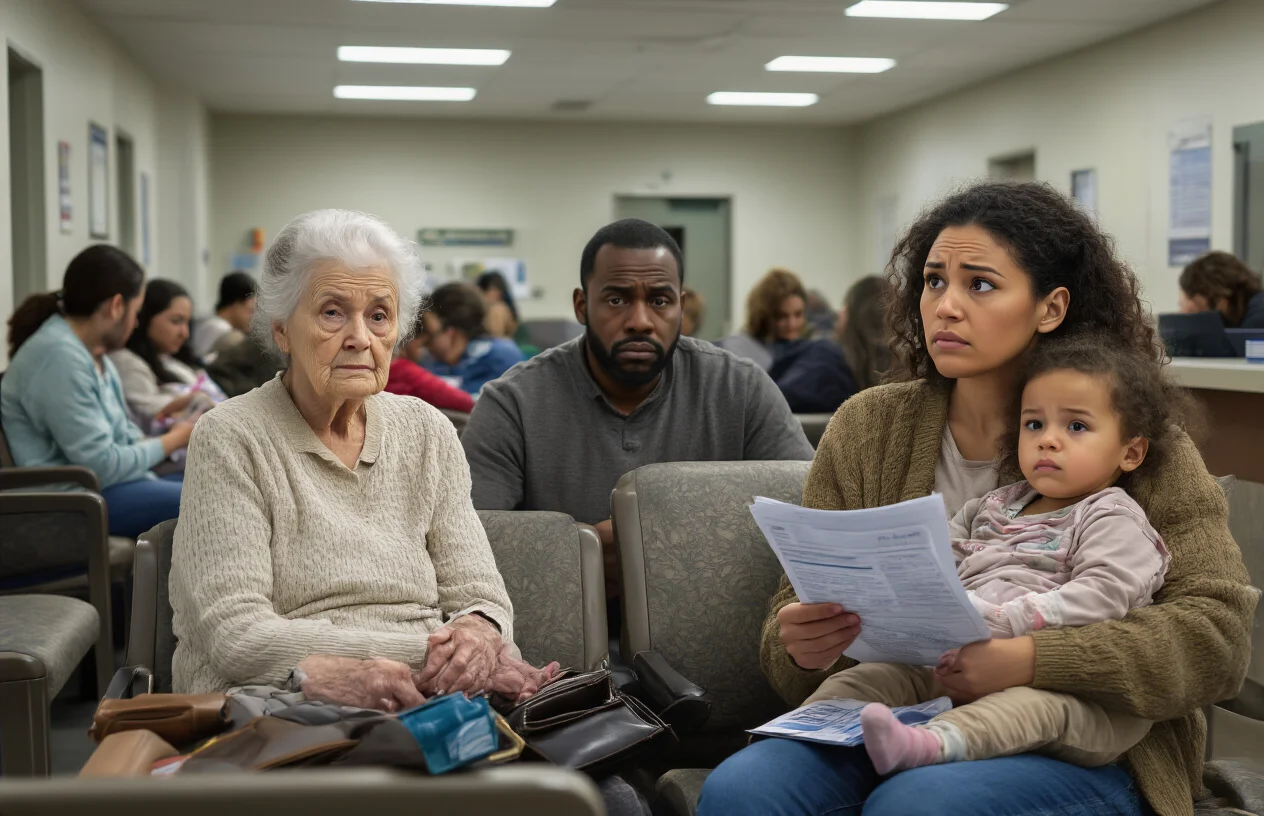Americans face unprecedented public health challenges that demand immediate attention and comprehensive solutions. These interconnected issues affect millions of people across all demographics and communities, creating ripple effects throughout the healthcare system and society at large.
This analysis targets healthcare professionals, policymakers, community leaders, and concerned citizens who need to understand the scope and impact of today’s most pressing health crises. The information provides essential context for anyone working to improve population health outcomes or advocating for systemic healthcare reforms.
The discussion examines three critical areas shaping America’s health landscape. First, the mental health crisis continues to escalate, with nearly 60 million adults experiencing mental illness while access to treatment remains limited. Second, rising obesity rates fuel an epidemic of chronic diseases including diabetes, heart disease, and stroke, creating massive healthcare costs and reducing quality of life for millions. Finally, healthcare access barriers prevent many Americans from receiving preventive care and timely treatment, particularly affecting underserved communities and low-income populations.
These public health challenges require coordinated responses involving medical professionals, government agencies, community organizations, and individual citizens working together to create lasting solutions.
Mental Health Crisis and Its Widespread Impact

Rising Depression and Anxiety Rates Across Age Groups
The mental health epidemic represents one of the most pressing public health challenges facing the nation today. Current data reveals that 23 percent of American adults, nearly 60 million people, experienced some form of mental illness, highlighting the extensive reach of this crisis across diverse populations. The scope of anxiety disorders has shown particularly alarming growth, with 43 percent of American adults reporting increased anxiety levels—representing a 6 percent increase from 2023 and an 11 percent surge from 2022.
This upward trajectory in mental health epidemic cases demonstrates the widespread nature of psychological distress affecting individuals regardless of age, socioeconomic status, or geographic location. The statistical evidence underscores how mental health conditions have evolved from isolated cases to a comprehensive American healthcare crisis requiring immediate attention and systematic intervention.
Suicide Prevention and Early Intervention Strategies
Mental illnesses frequently escalate to life-threatening situations, with these conditions leading to suicidal thoughts among affected individuals. The severity of this progression becomes evident when examining national mortality data, which identifies suicide as the 11th leading cause of death among Americans. This devastating outcome claimed 49,316 lives in 2023, emphasizing the critical importance of implementing robust prevention frameworks.
Early intervention strategies must address the progression from mental illness to suicidal ideation through comprehensive screening protocols and immediate response systems. The connection between untreated mental health conditions and fatal outcomes demonstrates the urgent need for accessible crisis intervention services that can identify at-risk individuals before they reach critical stages.
Breaking Stigma Around Mental Health Treatment
A significant barrier to addressing the mental health epidemic lies in the widespread issue of untreated mental illnesses. Many individuals suffering from psychological conditions never receive appropriate care, often due to societal stigma surrounding mental health treatment. This treatment gap perpetuates the cycle of deteriorating mental health outcomes and contributes to the rising statistics in anxiety and depression cases.
Professional healthcare systems must prioritize destigmatization efforts that normalize mental health care as essential medical treatment. Educational initiatives and awareness campaigns play crucial roles in encouraging individuals to seek professional help without fear of social judgment or professional repercussions.
Workplace Mental Health Support Systems
Given that 43 percent of American adults report increased anxiety levels, workplace environments must adapt to support employee mental wellness. Organizations increasingly recognize their responsibility in addressing mental health challenges that affect productivity, retention, and overall workplace culture. Comprehensive support systems should include employee assistance programs, mental health days, and access to counseling services.
Effective workplace mental health initiatives can serve as early intervention points, potentially preventing the escalation of conditions that might otherwise contribute to the alarming suicide rates documented in recent statistics.
Obesity Epidemic and Related Chronic Diseases

Understanding Root Causes of Weight Gain Nationwide
Excessive body weight significantly impacts the overall health of individuals and the general public, creating one of the most pressing public health challenges facing Americans today. The obesity epidemic has reached alarming proportions, with multiple interconnected factors contributing to nationwide weight gain patterns.
Key factors in weight management include nutrition and physical fitness, which serve as fundamental pillars for maintaining healthy body weight. Poor dietary choices, characterized by high-calorie processed foods and inadequate nutrient intake, combine with sedentary lifestyles to create an environment conducive to weight gain. Physical inactivity has become increasingly prevalent across American communities, further exacerbating the obesity crisis.
The widespread impact of excessive body weight extends beyond individual health concerns, affecting healthcare systems, economic productivity, and community well-being. Understanding these root causes becomes essential for developing comprehensive strategies to address the obesity epidemic effectively.
Diabetes Prevention Through Lifestyle Modifications
Obesity has been tied to potentially life-threatening conditions such as type 2 diabetes, making prevention through lifestyle modifications a critical component of chronic disease prevention strategies. The strong correlation between excessive body weight and diabetes development highlights the importance of maintaining healthy weights through targeted interventions.
Nutrition plays a pivotal role in diabetes prevention, with dietary modifications serving as the foundation for reducing diabetes risk. Implementing balanced eating patterns that emphasize whole foods, appropriate portion sizes, and reduced consumption of processed items can significantly decrease the likelihood of developing type 2 diabetes.
Physical fitness represents another essential element in diabetes prevention strategies. Regular physical activity helps maintain healthy weights, improves insulin sensitivity, and supports overall metabolic health. These lifestyle modifications work synergistically to decrease the likelihood of developing life-threatening conditions associated with obesity.
Heart Disease Risk Reduction Strategies
Heart disease accounted for one in every five deaths in the United States in 2022, amounting to approximately 702,880 deaths, establishing it as a leading cause of mortality. Common causes of heart disease include coronary artery disease (CAD) and heart attacks, conditions that are closely linked to obesity and related chronic diseases.
Obesity has been tied to potentially life-threatening conditions such as heart disease, making weight management a crucial strategy for cardiovascular risk reduction. Maintaining healthy weights through proper nutrition and physical fitness can significantly impact heart disease prevention efforts.
Risk reduction strategies center on addressing the key factors in weight management that directly influence cardiovascular health. Nutritional interventions that promote heart-healthy eating patterns, combined with regular physical activity, help individuals maintain optimal body weight while supporting cardiovascular function. These approaches work to decrease the likelihood of developing life-threatening conditions that contribute to the substantial mortality rates associated with heart disease in American populations.
Healthcare Access and Affordability Barriers

Insurance Coverage Gaps Affecting Treatment Decisions
Healthcare access and affordability barriers represent one of the most pressing public health challenges facing Americans today. Insurance coverage gaps significantly impact treatment decisions across all demographics, creating a cascade of delayed care and worsening health outcomes. Underinsured individuals often face difficult choices between necessary medical treatments and financial stability, leading to postponed preventive care and emergency interventions that could have been avoided with timely access to healthcare services.
The American healthcare crisis manifests through various coverage limitations, including high deductibles, copayments, and excluded services that force patients to prioritize immediate financial concerns over long-term health needs. These healthcare access barriers disproportionately affect middle-income families who earn too much to qualify for subsidies but struggle to afford comprehensive coverage.
Rural Healthcare Shortages and Transportation Challenges
Rural communities experience particularly severe healthcare access barriers, with physician shortages and facility closures creating substantial obstacles to care delivery. Transportation challenges compound these issues, as patients must travel significant distances to reach specialized services, often resulting in missed appointments and delayed treatments.
Healthcare infrastructure limitations in rural areas contribute to widening health disparities, forcing residents to rely on emergency departments for routine care or forgo treatment entirely. The combination of provider shortages and geographic isolation creates a perfect storm that undermines preventive healthcare initiatives and chronic disease management.
Prescription Drug Cost Management Solutions
Rising prescription drug costs represent a critical component of health insurance affordability concerns, with many Americans rationing medications or choosing between prescriptions and other essential needs. Generic alternatives and pharmaceutical assistance programs offer some relief, but complex prior authorization requirements often create additional barriers to accessing necessary medications.
Patient assistance programs and pharmacy benefit management strategies provide potential solutions, though awareness and accessibility remain significant challenges for vulnerable populations already struggling with healthcare access barriers.
Emergency Room Overcrowding and Alternative Care Options
Emergency departments increasingly serve as safety nets for uninsured and underinsured populations, contributing to overcrowding and extended wait times that compromise care quality for all patients. This overreliance on emergency services drives up healthcare costs while failing to address underlying health conditions effectively.
Urgent care centers, telehealth services, and community health centers offer alternative care options that can alleviate emergency room pressure while providing more appropriate and cost-effective treatment for non-emergency conditions. Expanding these alternatives requires coordinated investment in healthcare infrastructure and workforce development.
Specialist Wait Times and Care Coordination Issues
Extended specialist wait times and fragmented care coordination create additional layers of complexity within the American healthcare crisis. Patients often experience delays in accessing specialized care, leading to disease progression and increased treatment costs over time.
Poor communication between primary care providers and specialists compounds these challenges, resulting in duplicated tests, medication conflicts, and gaps in treatment continuity. Effective care coordination systems and improved provider communication networks are essential for addressing these systemic inefficiencies and improving patient outcomes while controlling costs.
Environmental Health Threats and Protection Measures

Air Quality Improvement for Respiratory Health
Environmental health risks pose significant threats to public health outcomes across the United States. Air quality deterioration directly correlates with increased respiratory conditions, cardiovascular diseases, and premature mortality rates. Poor air quality disproportionately affects vulnerable populations, including children, elderly individuals, and those with pre-existing health conditions.
Industrial emissions, vehicular pollution, and wildfire smoke contribute to elevated particulate matter concentrations in urban and rural areas. These airborne contaminants penetrate deep into lung tissues, triggering inflammatory responses and exacerbating asthma, chronic obstructive pulmonary disease, and other respiratory ailments. Implementing stricter emission standards, promoting cleaner transportation alternatives, and establishing air quality monitoring systems remain essential protective measures.
Water Contamination Prevention and Testing
Water quality degradation presents another critical environmental health challenge requiring immediate attention. Contaminated water sources expose communities to harmful bacteria, heavy metals, and chemical pollutants that can cause gastrointestinal illnesses, neurological disorders, and long-term health complications.
Regular water testing protocols help identify potential contamination sources before they reach public consumption levels. Infrastructure improvements, including updated filtration systems and pipeline replacements, serve as fundamental prevention strategies. Community education programs emphasizing proper water storage and treatment methods further enhance protection against waterborne diseases.
Climate Change Health Impacts and Adaptation
Climate change represents one of the greatest challenges to public health, according to a 2023 report from the World Health Organization. The WHO estimates that one in four human deaths result from environmental factors exacerbated by climate change. Rising temperatures, extreme weather events, and shifting disease patterns directly impact community health outcomes.
Heat-related illnesses increase during prolonged temperature spikes, particularly affecting outdoor workers and individuals without adequate cooling systems. Flooding and severe storms compromise infrastructure, limiting access to healthcare services and clean water supplies. Vector-borne diseases expand their geographic range as warming temperatures create favorable conditions for disease-carrying insects.
Adaptation strategies include developing heat emergency response plans, strengthening healthcare infrastructure resilience, and implementing early warning systems for extreme weather events. Public health agencies must collaborate with environmental scientists and urban planners to create comprehensive climate adaptation frameworks that protect vulnerable populations from escalating environmental health risks.
Substance Abuse and Addiction Recovery Systems

Opioid Crisis Response and Treatment Programs
The opioid epidemic represents one of the most pressing substance abuse prevention challenges facing American healthcare systems today. Treatment programs have emerged as critical components in addressing this multifaceted crisis, focusing on evidence-based interventions that combine medical treatment with comprehensive support services. These programs typically incorporate medication-assisted treatment (MAT), counseling services, and peer support networks to create sustainable pathways to recovery.
Recovery systems have evolved to address the complex nature of opioid dependency, recognizing that effective treatment requires long-term commitment and multidisciplinary approaches. Treatment facilities now emphasize individualized care plans that address underlying factors contributing to substance misuse while providing immediate medical stabilization and ongoing therapeutic support.
Alcohol Abuse Prevention and Community Support
With approximately 28.9 million Americans ages 12 and older identified as having an alcohol use disorder (AUD) in 2023, comprehensive prevention strategies have become essential components of public health initiatives. Community-based programs focus on education, early intervention, and creating supportive environments that reduce risk factors associated with alcohol misuse.
Prevention efforts target multiple demographics through tailored approaches that address specific risk factors within different populations. These initiatives emphasize building resilience, promoting healthy coping mechanisms, and creating community networks that support individuals at risk of developing alcohol-related disorders.
Prescription Drug Misuse Awareness
Prescription drug misuse represents a significant public health challenge, with approximately 16.3 million Americans misusing prescription drugs over a 12-month period. Awareness campaigns focus on educating both healthcare providers and patients about proper medication management, storage, and disposal practices to prevent diversion and unintended consequences.
Educational initiatives emphasize the importance of following prescribed dosages, understanding potential side effects, and recognizing early warning signs of dependency. Healthcare systems have implemented monitoring programs and prescribing guidelines to reduce inappropriate access to potentially addictive medications while ensuring legitimate medical needs are met.
Recovery Resource Accessibility and Funding
Access to comprehensive recovery resources remains a critical barrier in addressing substance abuse prevention effectively. Funding challenges often limit the availability of treatment programs, particularly in underserved communities where the need for services may be greatest. Recovery systems require sustained financial support to maintain quality services and expand capacity to meet growing demand.
Resource accessibility encompasses not only treatment availability but also transportation, childcare, and other support services that enable individuals to participate in recovery programs. Addressing these systemic barriers requires coordinated efforts between healthcare providers, community organizations, and policymakers to create comprehensive support networks that facilitate long-term recovery success.
Preventive Care and Health Education Initiatives

Vaccination Coverage and Public Health Protection
Vaccination programs remain cornerstone initiatives in preventive healthcare, serving as critical barriers against infectious disease outbreaks. These public health interventions demonstrate the effectiveness of systematic preventive approaches in reducing morbidity and mortality rates across populations. Healthcare systems continue to emphasize vaccination coverage as fundamental to community health protection, particularly in vulnerable demographic groups.
Cancer Screening Programs and Early Detection
With this in mind, cancer screening programs represent essential preventive healthcare initiatives, particularly given the alarming projections from the American Cancer Society. The organization anticipates 2,041,910 new cancer cases and projects 618,120 cancer-related deaths in the United States in 2025, highlighting the critical importance of early detection strategies. These screening programs become increasingly vital as cancer continues to cause harmful cells to multiply uncontrollably throughout the body.
The concerning trend shows that odds of developing cancer have increased with each generation, particularly affecting individuals under 50 years of age. This demographic shift emphasizes the urgent need for comprehensive screening initiatives targeting younger populations. While scientists have not yet found a cure for this disease that has become increasingly common, early detection through systematic screening programs remains the most effective approach to improving patient outcomes and survival rates.
Nutrition Education for Disease Prevention
Now that we have covered screening initiatives, nutrition education emerges as another fundamental component of preventive healthcare initiatives. Proper nutrition serves as a key factor in weight management, enabling individuals to maintain healthy weights while simultaneously decreasing their likelihood of developing life-threatening conditions. These educational programs focus on evidence-based dietary approaches that support optimal health outcomes.
Physical Activity Promotion in Communities
Previously established research demonstrates that physical fitness, alongside nutrition, constitutes a crucial element in comprehensive weight management strategies. Community-based physical activity promotion programs work synergistically with nutritional interventions to help individuals maintain healthy weights. These initiatives recognize that combined approaches addressing both dietary habits and exercise patterns provide the most effective framework for reducing the risk of developing chronic diseases and other life-threatening conditions within American communities.

The public health challenges facing Americans today represent interconnected crises that demand immediate and sustained attention. From the mental health epidemic affecting nearly 60 million adults to the obesity crisis contributing to cardiovascular disease and diabetes, these issues create cascading effects throughout communities. Healthcare access barriers, environmental threats, substance abuse disorders, and inadequate preventive care education further compound these problems, creating a complex web of health disparities that disproportionately impact vulnerable populations.
Addressing these multifaceted challenges requires a comprehensive approach involving healthcare professionals, policymakers, communities, and individuals working together. Public health professionals—including epidemiologists, health educators, and policy analysts—play crucial roles in developing evidence-based interventions and prevention strategies. The path forward demands increased investment in mental health services, improved healthcare accessibility, robust environmental protection measures, comprehensive substance abuse treatment programs, and widespread health education initiatives. Only through coordinated efforts across all sectors can America build a healthier, more resilient future for all its citizens.




